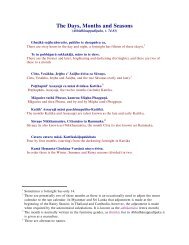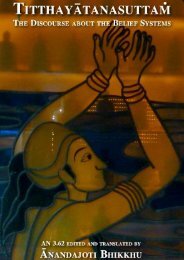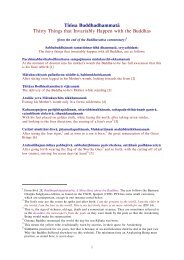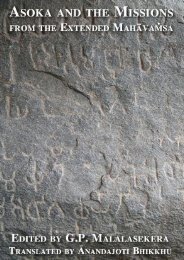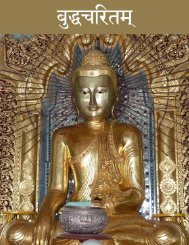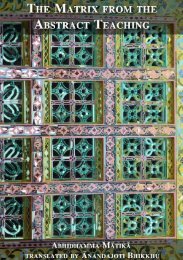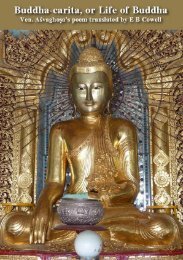Metre in Classical Sanskrit - Ancient Buddhist Texts
Metre in Classical Sanskrit - Ancient Buddhist Texts
Metre in Classical Sanskrit - Ancient Buddhist Texts
You also want an ePaper? Increase the reach of your titles
YUMPU automatically turns print PDFs into web optimized ePapers that Google loves.
fromA <strong>Sanskrit</strong> Grammar for StudentsbyArthur Anthony MacdonellAppendix II:<strong>Metre</strong> <strong>in</strong> <strong>Classical</strong> <strong>Sanskrit</strong>The versification of classical <strong>Sanskrit</strong> differs considerably fromthat of the Vedic hymns, be<strong>in</strong>g more artificial, more subject tostrict rules, and show<strong>in</strong>g a far greater number of varieties of metre.<strong>Classical</strong> <strong>Sanskrit</strong> metres are divided <strong>in</strong>to—I. those measured by the number of syllables;II. those measured by the number of moræ they conta<strong>in</strong>.Nearly all <strong>Sanskrit</strong> poetry is written <strong>in</strong> stanzas consist<strong>in</strong>g of fourmetrical l<strong>in</strong>es or quarter-verses (called pāda, ‘foot’ = quarter).These stanzas are regularly divided <strong>in</strong>to hemistichs or half-verses.Quantity is measured as <strong>in</strong> Lat<strong>in</strong> and Greek. Vowels are long bynature or by position. Two consonants make a preced<strong>in</strong>g shortvowel long by position, Anusvāra and Visarga count<strong>in</strong>g as fullconsonants. A short vowel counts as one mora (mātrā), a longvowel (by nature or position) as two.
A.A. Macdonell on <strong>Metre</strong> <strong>in</strong> <strong>Classical</strong> <strong>Sanskrit</strong> - 2These consist of—I. <strong>Metre</strong>s measured by Syllables(Akṣara-cchandaḥ)A. two half-verses identical <strong>in</strong> structure, while the quarterversesI and 3 differ from 2 and 4.B. four quarter-verses all identical <strong>in</strong> structure.A. The Śloka.The Śloka (‘song,’ from śru, ‘hear’), developed from the VedicAnuṣṭubh, is the Epic verse, and may be considered the Indianverse par excellence, occurr<strong>in</strong>g, as it does, far more frequently thanany other metre <strong>in</strong> classical <strong>Sanskrit</strong> poetry. It consists of two halfversesof sixteen syllables or of four pādas of eight syllables.Divid<strong>in</strong>g the half-verse <strong>in</strong>to four feet of four syllables, we f<strong>in</strong>d thatonly the second and the fourth foot are determ<strong>in</strong>ed as to quantity.The fourth is necessarily iambic (⏑−⏑⏓) while the second mayassume four different forms. The first and the third foot areundeterm<strong>in</strong>ed, except that ⏓⏑⏑⏓ is always excluded from them.By far the commonest form of the second foot is ⏑−−⏓ (<strong>in</strong> Nala1442 out of 1732 half-verses).The type of the Śloka may therefore be represented thus—E.g.· · · · ¦⏑−−⏓¦ · · · · ¦⏑−⏑⏓¦¦[−−−−¦⏑−−⏑¦−⏑−⏑¦⏑−⏑−]Āsīd rājā Nălō nāmă ¦ Vīrăsēnăsŭtō bălī[⏑⏑−−¦⏑−−−¦−⏑−−¦⏑−⏑⏑]ŭpăpannō gŭṇair iṣṭai ¦ rūpăvān aśvăkōvĭdăḥIt is only when the second foot has ⏑−−⏓ that the first foot mayassume all its admissible forms. When the second foot has any of
A.A. Macdonell on <strong>Metre</strong> <strong>in</strong> <strong>Classical</strong> <strong>Sanskrit</strong> - 3the other three forms, the first foot is limited, as shown <strong>in</strong> thefollow<strong>in</strong>g table:—I. II. III. IV.1. · · · · ¦ ⏑−− · ¦¦2a. · −⏑− ¦ ⏑⏑⏑ · ¦¦2b. · ⏑−− ¦ ⏑⏑⏑ · ¦¦ · · · · ¦ ⏑−⏑ · ¦¦3. · −⏑− ¦ −⏑⏑ · ¦¦4. · −⏑− ¦ −,−− · ¦¦The first (typical) form is called Pathyā the rema<strong>in</strong><strong>in</strong>g three calledVipulā, are <strong>in</strong> the above table arranged <strong>in</strong> order of frequency ofoccurrence. Out of 2579 half-verses taken from Kālidāsa (Raghuvaṁśaand Kumāra-sambhava), Māgha, Bhāravi, and Bilhaṇa, eachof the four admissible forms of the Śloka <strong>in</strong> the above order claimsthe follow<strong>in</strong>g share: 2289, 116, 89, 85.In the table a dot <strong>in</strong>dicates an undeterm<strong>in</strong>ed syllable: a commamarks the cæsura.The end of a pāda co<strong>in</strong>cides with the end of a word (sometimesonly with the end of a word <strong>in</strong> a compound), and the whole Ślokaconta<strong>in</strong>s a complete sentence. The construction does not run on<strong>in</strong>to the next l<strong>in</strong>e. Occasionally three half-verses are foundcomb<strong>in</strong>ed <strong>in</strong>to a triplet.B. All Four Pādas identical <strong>in</strong> Form.1. Of the numerous varieties developed from the Vedic Triṣṭubh(11 syllables to the pāda), the commonest are—a. Indravajrā: −−⏑¦−−⏑¦⏑−⏑¦−−¦¦b. Upendravrā: ⏑−⏑¦−−⏑¦⏑−⏑¦−−¦¦c. Upajāti (a mixture of the above two): ⏓−⏑¦−−⏑¦⏑−⏑¦−⏓¦¦d. Śāl<strong>in</strong>ī: −−−¦−,−⏑¦−−⏑¦−−¦¦e. Rathoddhatā: −⏑−¦⏑⏑⏑¦−⏑−¦−−¦¦
A.A. Macdonell on <strong>Metre</strong> <strong>in</strong> <strong>Classical</strong> <strong>Sanskrit</strong> - 42. The commonest forms of Jagatī (12 syllables to the pāda) are—a. Vaṁśastha: ⏑−⏑¦−−⏑¦⏑−⏑¦−⏑−¦¦b. Drutavilambita: ⏑⏑⏑¦−⏑⏑¦−⏑⏑¦−⏑−¦¦3. The commonest variety of Śakvarī (14 syllables to the pāda) is—Vasantatilakā: −−⏑¦−⏑⏑¦⏑−⏑¦⏑−⏑¦−⏓¦¦4. The commonest form of Atiśakvarī (15 syllables to the pāda)is—Māl<strong>in</strong>ī: ⏑⏑⏑¦⏑⏑⏑¦−−,−¦⏑−−¦⏑−⏓¦¦5. The commonest varieties of Atyaṣṭi (17 syllables to the pāda)are—a. Śikhariṇī: ⏑−−¦−−−,¦⏑⏑⏑¦⏑⏑−¦−⏑⏑¦⏑−¦¦b. Hariṇī: ⏑⏑⏑¦⏑⏑−,¦−−−¦−,⏑−¦⏑⏑−¦⏑−¦¦c. Mandākrāntā: −−−¦−,⏑⏑¦⏑⏑⏑¦−,−⏑¦−−⏑¦−⏓¦¦6. The commonest form of Atidhṛti (19 syllables to the pāda) is—Śārdūlavikrīḍita: −−−¦⏑⏑−¦⏑−⏑¦⏑⏑−,¦−−⏑¦−−⏑¦⏓¦¦7. The commonest variety of Prakṛti (21 syllables to the pāda) is—Sragdharā: −−−¦−⏑−¦−,⏑⏑¦⏑⏑⏑¦⏑−,−¦⏑−−¦⏑−−¦¦
A.A. Macdonell on <strong>Metre</strong> <strong>in</strong> <strong>Classical</strong> <strong>Sanskrit</strong> - 5II. <strong>Metre</strong>s measured by Moræ.A. <strong>Metre</strong>s <strong>in</strong> which the sum total only of the moræ is prescribed(Mātrā-chandhaḥ)The Vaitālīya conta<strong>in</strong>s 30 moræ <strong>in</strong> the half-verse, 14 <strong>in</strong> the firstpāda, 16 <strong>in</strong> the second. Each pāda may be divided <strong>in</strong>to three feet,the second always consist<strong>in</strong>g of a choriambus, and the third of twoiambics; while the first foot <strong>in</strong> the first pāda consists of a pyrrhic,<strong>in</strong> the second pāda of an anapæst. The half-verse thus conta<strong>in</strong>s 21syllables. The follow<strong>in</strong>g is the scheme of the half-verse:—⏑⏑¦−⏑⏑−¦⏑−⏑⏓¦¦⏑⏑−¦−⏑⏑−¦⏑−⏑⏓¦¦B. <strong>Metre</strong>s <strong>in</strong> which the number of moræ <strong>in</strong> each foot (gaṇa) isspecified (Gaṇa-cchandaḥ).Aryā or Gāthā has 7 1/2 feet to the half-verse, each foot conta<strong>in</strong><strong>in</strong>g4 moræ ( 30 moræ altogether). The 4 moræ may take the form⏑⏑⏑⏑,−−,−⏑⏑, or ⏑⏑−; <strong>in</strong> the 2nd and 4th they may alsobecome ⏑−⏑; <strong>in</strong> the 6th they appear as ⏑⏑⏑⏑ or ⏑−⏑. The 8thfoot is always monosyllabic; the 6th of the second half-verseconsists of a s<strong>in</strong>gle short syllable. Hence the second half-verseconta<strong>in</strong>s only 27 moræ.




